Latest Posts by needingsomespace - Page 3
Lo spazio è un po’ meno inospitale del previsto, almeno questo è quanto emerso in seguito ad un esperimento a lungo termine svolto su alcune alghe e portato avanti da Fraunhofer-Gesellschaft, una delle più grandi organizzazioni di ricerca applicata in Europa, grazie alla collaborazione del governo tedesco e altri partner internazionali, tra cui la Stazione Spaziale Internazionale ISS.
Il progetto, capitanato dal Dr. Thomas Leya, a capo del team Extremophile Research & Biobank CCCryo appartenente alla sezione Bioanalytics and Bioprocesses IZI-BB di Fraunhofer a Postdam, rientra all'interno di un programma più ampio del Centro Aerospaziale Tedesco, chiamato Biology and Mars Experiment (BIOMEX). (Nota: CCCryo è l'acronimo di Culture Collection of Cryophilic Algae).
Lo scopo del progetto è stato quello di valutare la resistenza alle condizioni estreme offerte dallo spazio da parte di alcune alghe. Infatti, non potendo ricreare le medesime condizioni in laboratorio, il team di ricerca di Leya ha inviato sulla ISS alcuni campioni di alga attraverso l'utilizzo di un modulo Progress russo in data 13 luglio 2014, mentre le operazioni di rientro sono state affidate recentemente ad una capsula Soyuz.
Come lecito attendersi, le alghe prese in considerazione presentano delle specifiche peculiarità, tra cui particolari geni in grado di renderle naturalmente resistenti alle condizioni climatiche più rigide presenti sul globo. I campioni sono stati quindi scelti in base alla presenza dei geni Sphaerocystis sp. e il cianobatterio Nostoc sp., rispettivamente caratteristici delle alghe verdi norvegesi e delle alghe blu-verdi delle regioni antartiche, veri e propri esempi viventi di alghe in grado di sviluppare strategie di adattamento in grado di contrastare il freddo e l'essicazione.
I campioni ottenuti sono stati quindi trasportati sulla ISS per poter verificare la loro capacità di resistere, per un periodo di tempo prolungato, a condizioni che includono forti sbalzi termici, intense radiazioni UV e assenza di acqua prolungata. Le alghe in questione avevano già dimostrato di essere completamente resistenti a questi fattori durante la sperimentazione in laboratorio, tuttavia l'esperimento sulla ISS ha portato a risultati ancor più sorprendenti, dal momento che i campioni sono rimasti esposti alle condizioni estreme dello spazio nella parte esterna della ISS per ben 16 mesi, con solo un semplice filtro a densità neutra ad occuparsi di attenuare l'effetto delle radiazioni UV.
Tutti i cambiamenti di temperatura e di intensità delle radiazioni cosmiche sono stati monitorati e registrati attraverso una strumentazione dedicata; l'analisi del loro log sarà utile al fine di analizzare le esatte condizioni a cui sono stati sottoposti i campioni in questi 16 mesi, tornati intatti sulla Terra e in grado di dare il via a nuove colonie di alghe.
Ora che le alghe sono state recuperate non si può certo dire che l'esperimento sia concluso. Al momento i campioni sono in fase di analisi presso la Technische Universität di Berlino, la quale accerterà se il periodo trascorso nello spazio ha provocato danni nel DNA delle alghe e, nel caso in cui fossero presenti, quali sono le conseguenze di ciò. Le radiazioni UV a cui sono state esposte, infatti, sono estremamente pericolose per il DNA degli esseri umani, tuttavia ogni forma di vita reagisce in maniera diversa a queste condizioni avverse.
I risultati che produrrà questa ricerca saranno particolarmente interessanti, in quanto il loro campo di applicazione è molto vasto; si va dalla cosmetica, grazie alla realizzazione di protezioni solari che possano sfruttare le proprietà di queste alghe, sino alla possibilità di utilizzarle come aspetto fondamentale in una prossima spedizione su Marte. Ed è proprio questo lo scopo finale di questo esperimento; aiutare l'uomo a trovare soluzioni in grado di adattarsi a condizioni climatiche molto diverse da quelle naturalmente disponibili sulla Terra.
L'utilizzo di queste alghe, infatti, potrebbe rappresentare una base importante da cui partire per avviare la produzione indipendente di ossigeno sul pianeta rosso, uno degli aspetti principali per permettere ai moduli abitativi e alle prime colonie di potersi sostenere autonomamente. Ma non solo ossigeno, dal momento che le alghe sono anche un'importante fonte di proteine e potranno aiutare i primi coloni nella realizzazione dei pasti, sia durante la fase di viaggio che di insediamento. Abbiamo visto come Marte rappresenti una frontiera sempre più ambita da enti pubblici e privati, i quali si stanno preparando a quella che sembra essere la prossima grande corsa allo spazio. Tra tutti troviamo in testa Elon Musk, pronto a lanciarsi alla conquista del pianeta rosso con un progetto dettagliato e ambizioso; chissà che anche lui non abbia trovato particolarmente stimolante l'esperimento di Fraunhofer.



Solar System: Things to Know This Week
Follow our Juno craft during a close flyby of Jupiter, learn about Cassini’s final mission during a Facebook live event (in case you missed it) and more!

1. Jupiter, Up Close
Our Juno mission completed a close flyby of Jupiter on Thursday, February 2, its latest science orbit of the mission. All of Juno’s science instruments and the spacecraft’s JunoCam were operating during the flyby to collect data that is now being returned to Earth.

Want to know more? Using NASA’s Eyes on the Solar System and simulated data from the Juno flight team you can ride onboard the Juno spacecraft in real-time at any moment during the entire mission.

2. In Case You Missed It–Cassini Facebook Live
Cassini Project Scientist Linda Spilker and mission planner Molly Bittner take questions about the mission’s “Ring-Grazing” orbits during Facebook Live. Watch it now: www.facebook.com/NASA/videos/10154861046561772/

3. Cassini Scientist for a Day Essay Contest
The deadline is Friday, February 24 for U.S. student in grades 5 to 12. For international students, visit the page for more info!
More: solarsystem.nasa.gov/educ/Scientist-For-a-Day/2016-17/videos/intro

4. Cassini Spies Dione
Dione’s lit hemisphere faces away from Cassini’s camera, yet the moon’s darkened surface are dimly illuminated in this image, due to the phenomenon of Saturnshine. Although direct sunlight provides the best illumination for imaging, light reflected off of Saturn can do the job as well. In this image, Dione (698 miles or 1,123 kilometers across) is above Saturn’s day side, and the moon’s night side is faintly illuminated by sunlight reflected off the planet’s disk.
Discover the full list of 10 things to know about our solar system this week HERE.
Follow us on Tumblr for your regular dose of space: http://nasa.tumblr.com
Flying to New Heights With the Magnetospheric Multiscale Mission
A mission studying Earth’s magnetic field by flying four identical spacecraft is headed into new territory.

The Magnetospheric Multiscale mission, or MMS, has been studying the magnetic field on the side of Earth facing the sun, the day side – but now we’re focusing on something else. On February 9, MMS started the three-month-long process of shifting to a new orbit.

One key thing MMS studies is magnetic reconnection – a process that occurs when magnetic fields collide and re-align explosively into new positions. The new orbit will allow MMS to study reconnection on the night side of the Earth, farther from the sun.

Magnetic reconnection on the night side of Earth is thought to be responsible for causing the northern and southern lights.

To study the interesting regions of Earth’s magnetic field on the night side, the four MMS spacecraft are being boosted into an orbit that takes them farther from Earth than ever before. Once it reaches its final orbit, MMS will shatter its previous Guinness World Record for highest altitude fix of a GPS.
To save on fuel, the orbit is slowly adjusted over many weeks. The boost to take each spacecraft to its final orbit will happen during the first week of April.

On April 19, each spacecraft will be boosted again to raise its closest approach to Earth, called perigee. Without this step, the spacecraft would be way too close for comfort – and would actually reenter Earth’s atmosphere next winter!

The four MMS spacecraft usually fly really close together – only four miles between them – in a special pyramid formation called a tetrahedral, which allows us to examine the magnetic environment in three dimensions.

But during orbit adjustments, the pyramid shape is broken up to make sure the spacecraft have plenty of room to maneuver. Once MMS reaches its new orbit in May, the spacecraft will be realigned into their tetrahedral formation and ready to do more 3D magnetic science.

Learn more about MMS and find out what it’s like to fly a spacecraft.

Una futura missione per l'atterraggio una sonda robotizzata sulla luna ghiacciata di Giove, Europa, potrebbe essere nei progetti della NASA. La relazione sul potenziale valore scientifico di tale missione, si propone di coinvolgere la comunità scientifica più ampia sui meriti di tale ricerca. L'obiettivo primario è la ricerca di prove di vita.
Potentially Hospitable Enceladus
NASA & ESA - Cassini-Huygens Mission to Saturn & Titan patch. Feb. 6, 2017
Seen from outside, Enceladus appears to be like most of its sibling moons: cold, icy and inhospitable. But under that forbidding exterior may exist the very conditions needed for life. Over the course of the Cassini mission, observations have shown that Enceladus (313 miles or 504 kilometers across) not only has watery jets sending icy grains into space; under its icy crust it also has a global ocean, and may have hydrothermal activity as well. Since scientists believe liquid water is a key ingredient for life, the implications for future missions searching for life elsewhere in our solar system could be significant. This view looks toward the Saturn-facing hemisphere of Enceladus. North on Enceladus is up and rotated 6 degrees to the right. The image was taken in green light with the Cassini spacecraft narrow-angle camera on Nov. 27, 2016. The view was obtained at a distance of approximately 81,000 miles (130,000 kilometers) from Enceladus. Image scale is 2,566 feet (782 meters) per pixel.
Cassini spacecraft around Saturn
The Cassini mission is a cooperative project of NASA, ESA (the European Space Agency) and the Italian Space Agency. The Jet Propulsion Laboratory, a division of the California Institute of Technology in Pasadena, manages the mission for NASA’s Science Mission Directorate, Washington. The Cassini orbiter and its two onboard cameras were designed, developed and assembled at JPL. The imaging operations center is based at the Space Science Institute in Boulder, Colorado. For more information about the Cassini-Huygens mission visit http://saturn.jpl.nasa.gov and http://www.nasa.gov/cassini. The Cassini imaging team homepage is at http://ciclops.org and http://www.esa.int/Our_Activities/Space_Science/Cassini-Huygens Images, Text, Credits: NASA/JPL-Caltech/Space Science Institute/Tony Greicius. Best regards, Orbiter.ch Full article

The rings of Saturn on February 2, 2016, observed by the Cassini space probe.
'News & Features': via #NASA_APP


TODAY IN HISTORY: On January 24, 1986, NASA’s Voyager 2 space probe made its closest approach to planet Uranus.

Dream and wish, as it’s human nature. As with the motto of my alma mater, North Carolina State University, think and do. Dare to dream, and then decide to make it happen. Landing on the moon was once science fiction. Make your dreams a reality. Roll up your sleeves and get to work.

Ship Ready for Return (Unfinished) - Chesley Bonestell

A magnificent moon looms large over the Space Shuttle Columbia at Cape Canaveral, 1981.

1968 North American Rockwell concept art depicts a Saturn V rocket rolling out from the Vehicle Assembly Building at Cape Canaveral.




John H. Glenn, 1921-2016 Time and Life magazine covers circa 1962 and 1998. One pair covered the flight of Friendship 7, the other, STS-95.
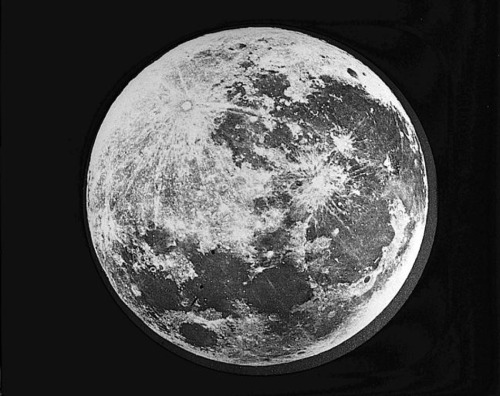
James Hall Nasmyth - Full Moon - 1874 - via Eastman Museum

Dictionnaire pittoresque d'histoire naturelle et des phénomènes de la nature - 1839 - via Internet Archive

The perihelion is the point in the orbit of the Earth where it is nearest to the Sun. It is the opposite of aphelion.
This concept can be applied to any orbiting object.
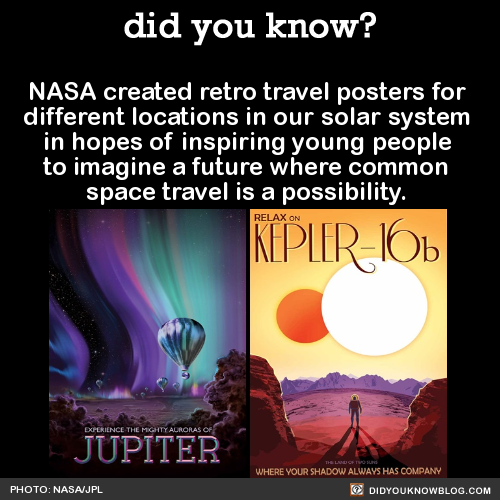

Quanti di voi sapevano che, sulla parte anteriore della coscia destra della tuta EMU degli astronauti delle missioni Apollo, ci fosse una specie di finestrella pensata appositamente per praticare iniezioni d’emergenza?
Si chiamava Biomedical Injection Patch ed era un disco di silicone attraverso il quale l’astronauta poteva iniettarsi farmaci in emergenza tramite delle siringhe automatiche a penna: il setto di silicone (non visibile nel riquadro perché nascosto da uno strato di tessuto) permetteva di non depressurizzare la tuta perché subito dopo la puntura ritorna elasticamente alla forma iniziale. Il funzionamento è simile a quello degli attuali port-a-cath utilizzati nella chemioterapia, dispositivi che hanno cominciato a diffondersi nei primi anni ’80 e che non mi stupirebbe scoprire che si ispirano a quelli progettati dalla NASA.
Nel kit, vi erano adrenalina e antivertiginosi (e qualcuno sostiene che vi era anche del cianuro, per eutanasie d'emergenza, nel caso qualcosa fosse andato storto).
Image Credits: NASA, Paul Calle Sources: Chi ha paura del buio? https://www.hq.nasa.gov/alsj/a14/A14ShepardFlownSuit.html https://ntrs.nasa.gov/archive/nasa/casi.ntrs.nasa.gov/20130011327.pdf http://history.nasa.gov/SP-368/s6ch6.htm


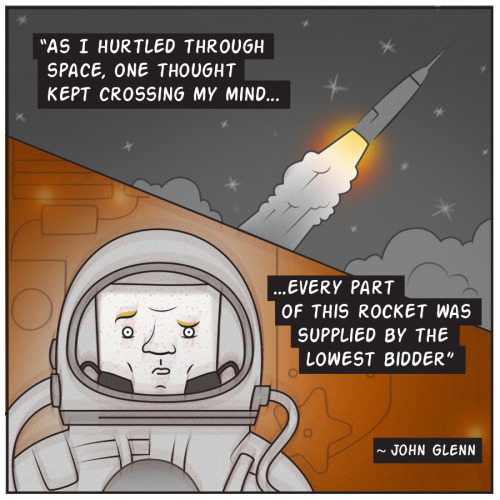
RIP John Glenn
What a man. John Glenn ❤

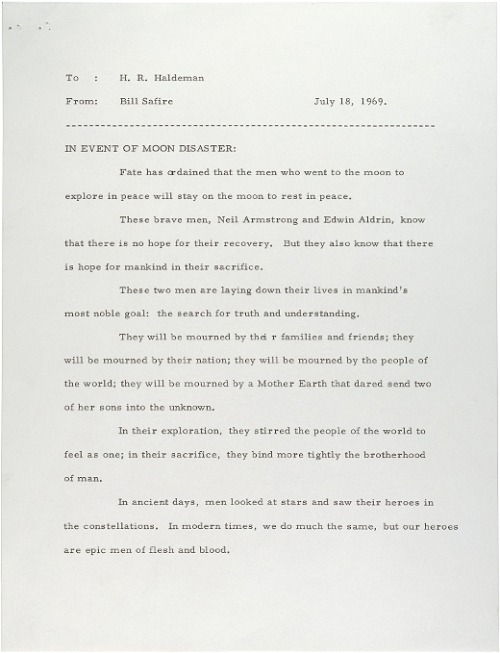

An address to the nation to be read by President Richard Nixon should the Apollo 11 astronauts become stranded on the moon,
To: H. R. Haldeman From: Bill Safire July 18, 1969. ——————————————————————————- IN EVENT OF MOON DISASTER: Fate has ordained that the men who went to the moon to explore in peace will stay on the moon to rest in peace. These brave men, Neil Armstrong and Edwin Aldrin, know that there is no hope for their recovery. But they also know that there is hope for mankind in their sacrifice. These two men are laying down their lives in mankind’s most noble goal: the search for truth and understanding. They will be mourned by their families and friends; they will be mourned by the nation; they will be mourned by the people of the world; they will be mourned by a Mother Earth that dared send two of her sons into the unknown. In their exploration, they stirred the people of the world to feel as one; in their sacrifice, they bind more tightly the brotherhood of man. In ancient days, men looked at the stars and saw their heroes in the constellations. In modern times, we do much the same, but our heroes are epic men of flesh and blood. Others will follow, and surely find their way home. Man’s search will not be denied. But these men were the first, and they will remain the foremost in our hearts. For every human being who looks up at the moon in the nights to come will know that there is some corner of another world that is forever mankind. PRIOR TO THE PRESIDENT’S STATEMENT: The President should telephone each of the widows-to-be. AFTER THE PRESIDENT’S STATEMENT, AT THE POINT WHEN NASA ENDS COMMUNICATIONS WITH THE MEN: A clergyman should adopt the same procedure as a burial at sea, commending their souls to “the deepest of the deep,” concluding with the Lord’s Prayer.

“Dear God, please don’t let me fuck up.”
—Alan Shepard
Don’t cry for Cassini: il lento suicidio nell’atmosfera del Signore degli Anelli
La sonda Cassini, lanciata il 15 ottobre 1997, è entrata in orbita attorno a Saturno il primo luglio del 2004. Prima di Cassini, Saturno veniva osservato quasi esclusivamente da Terra con l'eccezione delle immagini e dei dati raccolti dalle sonde Pioneer 11 e Voyager 1 e Voyager 2, che hanno effettuato dei flyby del pianeta, rispettivamente nel 1979, nel 1980 e nel 1981.
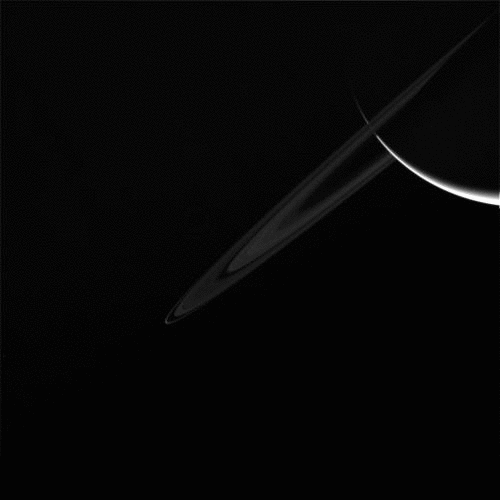
Cassini ha cambiato completamente la nostra visione di Saturno! Nei 12 anni trascorsi a orbitare attorno al pianeta, a fotografare e studiare i suoi anelli e le sue lune, la sonda ha percorso circa 2.2 miliardi di miglia dal suo arrivo nel 2004 e ha raccolto circa 600 GB di dati, scoperto 10 lune, inviato circa 380.000 immagini.
Oggi 30 novembre 2016 la missione Cassini della NASA inizierà una serie di orbite che la porteranno a spingersi oltre il bordo esterno degli anelli principali di Saturno (oltre le orbite dell'anello F), a 7.800 chilometri di distanza.

Gli ingegneri NASA stanno effettuando correzioni di rotta volte a modificare l'orbita di Cassini in modo da aumentare la sua inclinazione rispetto all'equatore e agli anelli di Saturno e di beneficiare di una "spinta" gravitazionale di Titano per inserirsi nella prima delle fasi conclusive della sua missione. Grazie a questo passaggio Cassini orbiterà attorno al polo Nord e al polo Sud del pianeta fino al 22 aprile 2017, tuffandosi ogni sette giorni nel bordo esterno degli anelli principali, per un totale di 20 volte, sfiorandoli per raccogliere campioni di molecole e gas

Durante queste orbite, Cassini passerà a circa 90.000 chilometri sopra alle nubi di Saturno: sarà una fase emozionante, ma sarà solo un preludio a quello che ci attenderà a partire dal mese di aprile, quando la sonda inizierà il Gran Finale, che terminerà il 15 settembre con il tuffo nell'atmosfera di Saturno.
Il motivo che ha portato gli scienziati a decidere per questa soluzione è che la sonda sta per esaurire il carburante e c'è l'esigenza di tutelare le lune di Saturno potenzialmente abitabili. A questo punto la soluzione scientificamente migliore è quella di progettare il fine missione in modo da condurre un'indagine straordinaria e non creare problemi al sistema di Saturno.

Solar System
via reddit






